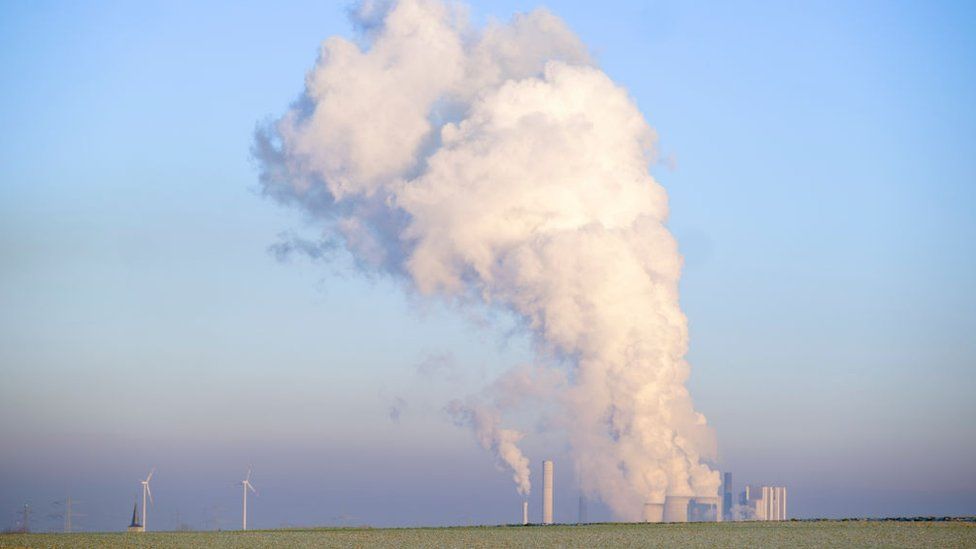ARTICLE AD BOX
 Image source, Getty Images
Image source, Getty Images
Emissions of CO2 from the power sector continue to push up temperatures
By Matt McGrath
Environment correspondent
A new way of sucking carbon dioxide from the air and storing it in the sea has been outlined by scientists.
The authors say that this novel approach captures CO2 from the atmosphere up to three times more efficiently than current methods.
The warming gas can be transformed into bicarbonate of soda and stored safely and cheaply in seawater.
The new method could speed up the deployment of carbon removal technology, experts say.
While the world has struggled to limit and reduce emissions of carbon dioxide in recent decades, several companies have instead focussed on developing technology to remove CO2 from the atmosphere.
Climeworks in Switzerland is perhaps the best known. Over the past ten years it has developed machines to suck in the air from the atmosphere that filter and trap the carbon dioxide molecules.
Image source, Getty Images
Image caption,Climeworks have established the world's largest direct air capture plant in Iceland
At a plant in Iceland the captured CO2 is injected deep underground where it is permanently turned into stone.
The company has recently started selling a certified carbon removal service to large corporate clients including Microsoft, Spotify and Stripe.
However, one big problem for most current approaches to direct air capture is cost.
CO2, although a powerful warming agent, is relatively diluted in the atmosphere at around 400 parts per million (ppm) in air.
So big machines that require large amounts of energy are needed to both absorb and discharge the CO2.
This new approach, using off-the-shelf resins and other chemicals, promises far greater efficiency and lower cost, say the scientists involved.
The research team have borrowed an approach used for applications in water, and "tweaked" existing materials to remove CO2 from the air.
In tests, the new hybrid absorbing material was able to take in three times as much CO2 as existing substances.
Image source, Getty Images
Image caption,Planting trees on a large scale, like here in China, is a cheap form of direct air capture but it uses large areas of land
"To my knowledge, there is no absorbing material which even at 100,000 ppm, shows the capacity we get it in direct air capture of 400 ppm," said lead author Prof Arup SenGupta from Lehigh University in the US.
"This simple ability to capture CO2 at a high quantity, in a small volume of material, is a unique aspect of our work."
The development, while in its early stages, has been welcomed by others in the field.
"I am happy to see this paper in the published literature, it is very exciting, and it stands a good chance of transforming the CO2 capture efforts," said Prof Catherine Peters from Princeton University, an expert in geological engineering, who wasn't involved in the research project.
"What is clever about this is that the starting point was a technology previously designed for applications in water. This advance applies this technology to the gas phase - a new idea."
"The demonstrated performance for CO2 capture is promising."
One of the big challenges in capturing CO2 is what to do with the trapped gas.
Storing it under the ground or sea in former oil wells is one widely used approach. But the new paper suggests that with the addition of some chemicals the captured CO2 can be transformed into bicarbonate of soda and stored simply and safely in sea water.
Image source, Getty Images
Image caption,Despite the rapid deployment of renewable energy, controlling rising temperatures will likely require extensive carbon removal as well
Dr SenGupta says he now wants to establish a spin-off company to develop the technology further.
He believes that removing CO2 in this way will not only be critical to limiting the rise in global temperatures but could also be directly empowering for developing countries.
"We have to take it to places like Bangladesh, Barbados or the Maldives, they also have a role to play, they cannot be just bystanders who keep suffering."
Some scientists are reluctant to put too much emphasis on new and emerging technologies like direct air capture because they fear that it could dilute the carbon cutting efforts of governments and individuals.
But with the temperature thresholds of the Paris climate agreement under threat from rising emissions, many others feel that the rapid deployment of direct air capture in addition to massive cuts in carbon is the best hope of avoiding dangerous climate change.
"It has become even more important now that we are definitely in an overshoot regime, where we have to take carbon back from the environment," said Prof Klaus Lackner, a pioneer in the field of removing CO2.
"DAC will have to get cheaper to make a useful contribution. I am optimistic that it can do this."
Professor SenGupta shares that optimism, believing that this new approach can remove CO2 for less than $100 a tonne.
The research has been published in the journal, Science Advances.

 1 year ago
37
1 year ago
37








 English (US)
English (US)